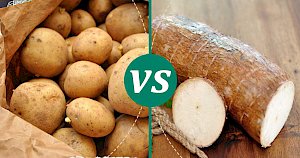Cassava vs Potato & Yam: Nutrition, Differences, and Benefits


Cassava vs Potato
Nutrition Facts
Serving size:
change
5g10g15g20g30g40g50g60g80g100g120g140g160g180g200g220g250g300g350g400g450g500g600g700g800g900g1000g
1oz2oz3oz4oz5oz6oz7oz8oz10oz12oz15oz20oz25oz30oz35oz40oz50oz
Amount Per Serving:
Serving size:
change
5g10g15g20g30g40g50g60g80g100g120g140g160g180g200g220g250g300g350g400g450g500g600g700g800g900g1000g
1oz2oz3oz4oz5oz6oz7oz8oz10oz12oz15oz20oz25oz30oz35oz40oz50oz
Amount Per Serving:
Cassava vs Potato 100g Compare
| per 100g | Cassava | Potato |
|---|---|---|
| Calories | 160 | 77 |
| Carbohydrates | 38.06 g | 17.49 g |
| Fat | 0.28 g | 0.09 g |
| Saturated fat | 0.07 g | 0.01 g |
| Dietary fiber | 1.8 g | 2.1 g |
| Protein | 1.36 g | 2.05 g |
| Water | 59.68 g | 79.25 g |
| Calcium | 16 mg | 12 mg |
| Iron | 0.27 mg | 0.81 mg |
| Magnessium | 21 mg | 23 mg |
| Potassium | 271 mg | 425 mg |
| Sodium | 14 mg | 6 mg |
| Vitaminium A | 13 µg | 2 µg |
| Vitaminium B1 (Thiamine) | 0.087 mg | 0.081 mg |
| Vitaminium B2 (riboflavin) | 0.048 mg | 0.032 mg |
| Vitaminium B3 (Niacin) | 0.854 mg | 1.061 mg |
| Vitaminium B6 | 0.088 mg | 0.298 mg |
| Vitaminium B9 (Folic acid) | 0.027 mg | 0.015 mg |
| Vitaminium C | 20.6 mg | 19.7 mg |
| Vitaminium E | 0.19 mg | 0.01 mg |
| Vitaminium K | 0.002 µg | 0.002 µg |
Exploring the Unique Qualities of Cassava, Potato, and Yam
Cassava, potato, and yam are staple root vegetables that hold cultural, economic, and nutritional significance across the globe. While they may look similar at first glance, their unique properties make each one distinct in terms of culinary use, growing conditions, and health benefits. Let’s dive deeper into what sets cassava, potato, and yam apart.
What Are Cassava, Potato, and Yam?
- Cassava (also known as yuca or manioc) is a tropical root vegetable native to South America. It plays a vital role in the diets of more than 500 million people worldwide, especially in regions with harsh climates where other crops fail. Cassava is not only a key ingredient in many traditional dishes but also a source of tapioca, a widely used starch.
- Potatoes originated in the Andes and have become one of the most widely consumed vegetables in the world. Known for their adaptability to various climates and soil types, potatoes are a dietary cornerstone in many cultures, contributing significantly to global food security.
- Yams are often confused with sweet potatoes but are entirely different. Native to Africa and Asia, yams are starchy tubers with a dry texture and unique flavor, making them a beloved ingredient in many traditional cuisines.
Comparing Cassava, Potato, and Yam
Understanding the differences between these tubers can help you choose the right one for your dietary or culinary needs.
Energy Content:
Cassava is significantly more energy-dense than potatoes and yams. This makes it an excellent choice for people needing high-calorie diets or for regions where food scarcity is a concern.Cultural Importance:
Potatoes were instrumental in shaping European population growth, while cassava has sustained millions in tropical regions. Yams hold cultural significance in African and Asian traditions, often being associated with festivals and rituals.Culinary Uses:
- Cassava is used to make flour, tapioca pearls, and traditional dishes like cassava cake or fufu.
- Potatoes are versatile, appearing in everything from mashed potatoes to French fries and gnocchi.
- Yams are commonly boiled, roasted, or mashed, often served in savory or sweet dishes.
Health Benefits and Dietary Considerations
Both cassava and potatoes are gluten-free, making them suitable for people with gluten sensitivities or celiac disease. However, cassava must be cooked thoroughly to remove natural toxins, while potatoes are generally safer to consume raw or cooked. Yams, like cassava, are rich in resistant starch, which supports gut health.
Key Takeaways:
- Cassava: Energy-dense, best for calorie needs and tropical cuisines.
- Potatoes: Higher protein and vitamin content, globally versatile.
- Yams: Unique flavor, culturally rich, and a healthy addition to meals.
Cassava vs Potato vs Yam: What to Choose?
In the cassava vs potato vs yam debate, the "winner" depends on your individual needs:
- For energy-dense meals, cassava takes the lead.
- For nutrient diversity and culinary flexibility, potatoes are unmatched.
- For distinct flavors and cultural significance, yams shine.
Instead of choosing just one, consider incorporating all three into your diet for a varied and nutrient-rich experience. These humble root vegetables each tell a story of resilience, tradition, and nourishment, offering a world of culinary possibilities.
Cassava 100g
160kcalCalories source
- 95% CARBS.
- 3% PROTEIN
- 2% FAT
Potato 100g
77kcalCalories source
- 89% CARBS
- 10% PROTEIN
- 1% FAT
Compares of cassava
- Cassava vs Beetroot
- Cassava vs Butternut Squash
- Cassava vs Carrot
- Cassava vs Cauliflower
- Cassava vs Kale
- Cassava vs Lotus Root
- see all compares of cassava
Marcin Piotrowicz
calories-info.com creator
Healthy diet and healthy lifestyle promoter
Add comment